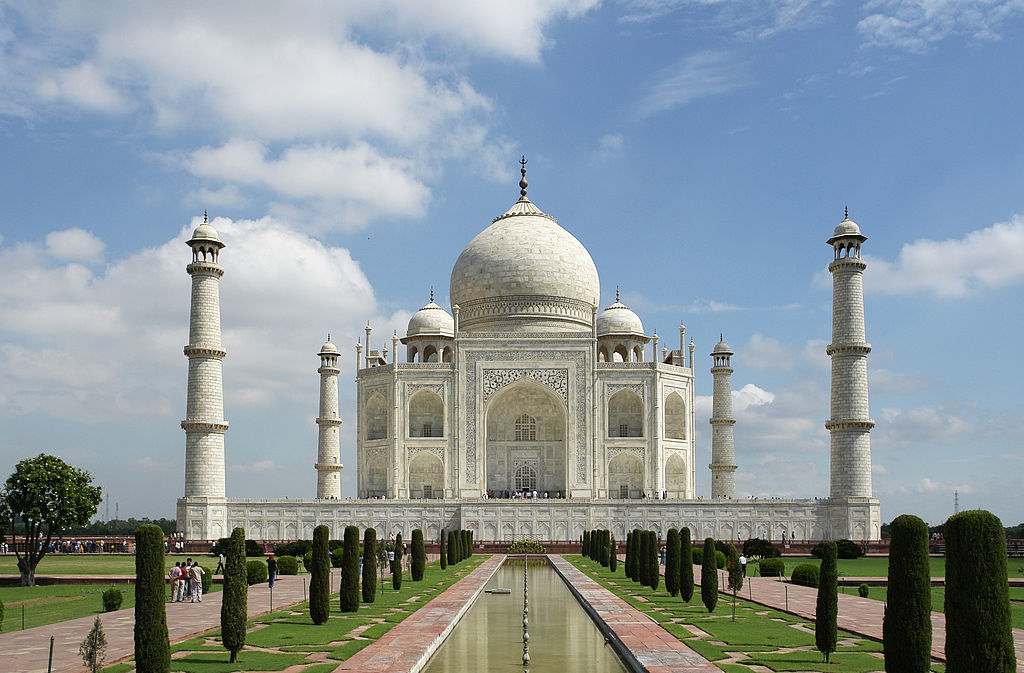
By YannWorld
ted by Jim Cartar (http://creativecommons.org/licenses/by-sa/4.0-3.0-2.5-2.0-1.0) or GFDL], via Wikimedia Commons
Standing majestically on the banks of River Yamuna, the Taj Mahal is synonymous to love and romance. The name "Taj Mahal" was derived from the name of Shah Jahan's wife, Mumtaz Mahal, and means "Crown Palace". The purity of the white marble, the exquisite ornamentation, precious gemstones used and its picturesque location, all make a visit to the Taj Mahal gain a place amongst the most sought-after tours in the world. However, until you know the love story behind the construction of the Taj Mahal, the beauty of the same would not enliven in your heart and mind and instead would come up as just another beautiful building/monument. It is the love behind this outstanding monument that has given a life to this monument. Come and explore the visceral charisma that it emanatesAt the brink of dawn when the first rays of the sun hits the dome of this epic monument, it radiates like a heavenly abode, cloaked in bright golden. And then at dusk, basking in the glory of moon, it shines like a perfectly carved diamond; appearing as if straight owwut of some magical tale, leaving the viewers awestruck by its sense of grandeur. Nothing short of an architectural marvel, no wonder it stands proud at being one of the Seven Wonders of the World. And the rich beauty of this visual spectacle turns visceral when one hears the story behind it. The story of Taj Mahal!
| Location: | On the banks of river Yamuna in Agra, Uttar Pradesh, India |
| Year of Construction: | 1631 - 1653 |
| Built By: | Mughal Emperor Shah Jahan |
| Spread Over: | 42 acres |
| Significance: | One of the Seven Wonders of the World |
How to Reach Taj Mahal
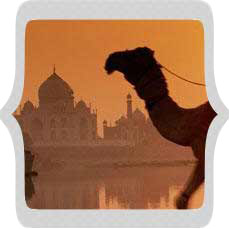
By Air
The fastest way of reaching Taj Mahal, Agra is by air. The city of Taj, Agra, has its own airport that is around 7 km from the city center. Indian Airlines operates flights to Agra on a daily basis.
By Rail
There is a good network of trains connecting Agra with the rest of the country. Apart from the main railway station of Agra Cantonment, there are other two stations also, that of Raja-ki-Mandi and Agra Fort. The main trains connecting Agra with Delhi are Palace on Wheels, Shatabdi, Rajdhani, and Taj Express.
By Road
There are regular bus services from Agra to a number of important cities. The main bus stand of Idgah has a number of buses running for Delhi, Jaipur, Mathura, Fatehpur-Sikri, etc.
Local Transportation
After reaching the city also, you need some sort of local transport to reach Taj Mahal. You can easily get taxi, tempo, auto-rickshaw and cycle rickshaw in the city that will take you to your destination. Prepaid taxis are also available if you want to visit the various places near the city. For the adventurous kind, there are bicycles that can be hired on hourly basis from different parts of the city. Since diesel and petrol vehicle are not permitted in the vicinity of Taj Mahal area, you can find battery-operated buses, horse-driven tongas, rickshaws and other pollution-free vehicles there.
Best Time to Visit Taj Mahal
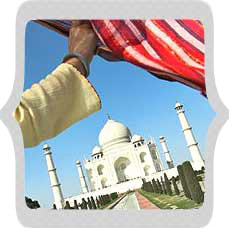
Just as there's no such thing as "a bad time to live", there's no such thing as "bad time to visit" one of the most scintillating and marvelous wonders of the world, the Taj Mahal. Whatever be the time of the year, the Taj Mahal will not stop with its mission to spread its charm and glory and will continue to be as luminescent as ever. But as a visit in the months of summers requires a high threshold to bear the heat, the period between the comparatively cooler months i.e. October to March is generally considered a best time to visit the Taj Mahal. Having said that, know that the radiance of the Taj Mahal is simply dazzling, and changes with every passing hour, reflecting a different aura in different seasons. Also, the visual beauty of the Taj Mahal is at its peak during sunrise, sunset, and under the full moon night.
Taj Mahal at Sunrise
Watching the sun rise up from under the sea of sky is a sight to behold, and what better way to experience it than to watch it take its place up there while you stand on the premises of one of the Seven Wonders of the World. It's a moment of delight when the beauty of the sunrise and the Taj Mahal culminate together to make for some awe-inspiring images of the Taj, being transformed from soft grey and pink to a soft red glow.
Taj Mahal at Sunset
After shining its glory all through the day, when the sun climbs down the stairway of heavens and gets ready to say adios to the world, it plays its final trick in the book by lending Taj Mahal a different appearance with the shades of fiery yellow being transformed into soft exotic orange and finally to pearl white again, until the full moon prepares itself to accompany the Taj all through the night while dazzling the world with its quiet heavenly elegance.
Taj Mahal under Full Moon Night
By the night when the full moon is high up in the sky, the beauty that Taj Mahal breathes out is beyond the scope of words. A silver glow that takes over Taj Mahal is so mesmerizing that most of the things you'll see after that will feel ordinary at best. This fabulous interplay of colors all through the day, and then night, symbolically implies the presence of God, who is never represented in the anthropomorphic form.
The best time to arrive would be just before the sunrise or sunset. Night viewing is allowed on the full moon night, two days before it and two days after it. Tickets for the same need to be booked one day in advance.
When visiting India browse through this beautiful list ofplaces to see in India to make your trip a memorable one.
Taj Mahal Timings
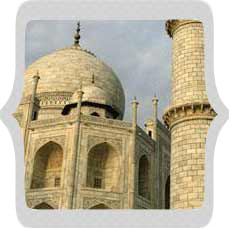
Night, 8:30 PM to 12:30 AM (On Full moon night, two days before and two days after)
Day Fee: Rs 750 (Foreigners)
Rs 510 (Citizens of SAARC and BIMSTEC Countries)
Rs 20 (Indian)
Entry Free for children below 15 years of age
Night Fee: Rs 750 (Adult, Foreign)
Rs 510 (Adult, Indian)
Rs 500 (Child 3-15 Years, Indian & Foreign)
Entry free for child below 3 years of age
The timings of visiting the Taj Mahal are set by the Archeological Survey of India. The Taj is opened all days of the week except for Fridays, when it is opened in the afternoon only for those who have to attend prayers at the Taj Mosque. The timings are from sunrise to sunset. Tickets are available throughout the day from the western and eastern gate, and at the southern gate tickets are available from 8:00 AM to 5:00 PM. The tourists can spend any number of hours inside the Taj complex from sunrise to sunset.
Night viewing at the Taj Mahal, from 8:30 PM to 12:30 AM, is allowed only on five nights in a month: one, on the full moon night, two days before it and two days after it, except for Fridays. However, night viewing is limited to maximum 400 people per night, divided into eight batches of 50 each and each batch is allowed to visit for a maximum duration of 30 minutes. The tickets for night viewing have to be booked one day (24 hours) in advance from the booking counter located in the office of the Archeological Survey of India, Agra Circle, 22 The Mall, Agra, Uttar Pradesh in between 10:00 AM to 6:00 PM.
History of Taj Mahal
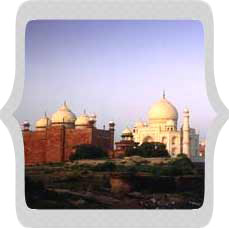
Mumtaz Mahal, an inseparable companion of Shah Jahan, died in 1631, while giving birth to their 14th child. It was in the memory of his beloved wife that Shah Jahan built a magnificent monument as a tribute to her, which we today know as the "Taj Mahal". The construction of Taj Mahal started in the year 1631. Masons, stonecutters, inlayers, carvers, painters, calligraphers, dome-builders and other artisans were requisitioned from the whole of the empire and also from Central Asia and Iran, and it took approximately 22 years to build what we see today. An epitome of love, it made use of the services of 22,000 laborers and 1,000 elephants. The monument was built entirely out of white marble, which was brought in from all over India and central Asia. After an expenditure of approximately 32 million rupees, Taj Mahal was finally completed in the year 1653.
It was soon after the completion of Taj Mahal that Shah Jahan was deposed by his own son Aurangzeb and was put under house arrest at nearby Agra Fort. Shah Jahan, himself also, lies entombed in this mausoleum along with his wife. Moving further down the history, it was at the end of the 19th century that British Viceroy Lord Curzon ordered a sweeping restoration project, which was completed in 1908, as a measure to restore what was lost during the Indian rebellion of 1857: Taj being blemished by British soldiers and government officials who also deprived the monument of its immaculate beauty by chiseling out precious stones and lapis lazuli from its walls. Also, the British style lawns that we see today adding on to the beauty of Taj were remodeled around the same time. Despite prevailing controversies, past and present threats from Indo-Pak war and environmental pollution, this epitome of love continuous to shine and attract people from all over the world.
Taj Mahal Facts

Fast Facts
Year of Construction: 1631
Completed In: 1653
Time Taken: 22 years
Built By: Shah Jahan
Dedicated to: Mumtaz Mahal (Arjumand Bano Begum), the wife of Shah Jahan
Location: Agra (Uttar Pradesh), India
Building Type: Islamic tomb
Architecture: Mughal (Combination of Persian, Islamic and Indian architecture style)
Architect: Ustad Ahmad Lahauri
Cost of Construction: 32 crore rupees
Number of workers: 20,000
Highlights: One of the Seven Wonders of the World; A UNESCO World Heritage Site
Timings: Sunrise to Sunset (Friday closed)
Fee: Rs 750 (Foreign Tourists)
Rs 510 (Citizens of SAARC & BIMSTEC Countries)
Rs 20 (Domestic Indian Tourists)
No Entry Fee for children below 15 years of age (Domestic or Foreigner)
Interesting Facts Of Taj Mahal
- Before his accession to the throne, Shah Jahan was popularly known as Prince Khurram.
- Shah Jahan fell in love with the beautiful Arjumand Bano Begum and married her, making her his third wife.
- Arjumand Bano Begum was christened by Shah Jahan as Mumtaz Mahal, meaning the “Chosen One Of The Palace” or “Jewel of the Palace”.
- Shah Jahan lost Mumtaz Mahal, when she died giving birth to their 14h child.
- For the transportation of the construction materials, more than 1,000 elephants were employed.
- As many as 28 different varieties of semi-precious and precious stones were used to adorn the Taj with exquisite inlay work.
- Depending on what time of the day it is and whether or not there’s moon at night, Taj Mahal appears to be of different color every time. Some even believe that this changing pattern of colors depict different moods of a woman.
- Passages from Quran have been used as decorative elements throughout the complex.
- On the sides of the actual tomb of Mumtaz Mahal, 99 names of Allah can be found as calligraphic inscriptions.
- Taj Mahal was built in stages, with the plinth and the tomb taking up roughly 15 years. Building of minarets, mosque, jawab, and gateway took additional 5 years to be completed.
- Different types of marbles used in construction of Taj Mahal were brought over from many different regions & countries: Rajasthan, Punjab, China, Tibet, Afghanistan, Srilanka, & Arabia.
- Many precious stones and Lapis Lazuli (a semi-precious stone) were ripped off from its walls by the Britishers during the Indian rebellion of 1857.
- Taj Mahal attracts 2-4 million visitors annually with over 200,000 from overseas.
2 comments:
I read that content, thanks for sharing very useful content
To get more- Taj Destinations & Travel Services
Visiting the Taj Mahal truly is like stepping into a timeless love story. Your post beautifully captures the emotion and grandeur behind this incredible monument. It’s amazing how the love of an emperor continues to inspire millions around the world. India really is a treasure trove for travelers seeking both history and heartfelt experiences. Thanks for sharing this wonderful perspective!
If you are planning on a trip, do visit some of our best-rated tours:
👉 Golden Triangle Tour 3 Days
👉 Golden Triangle Tour 4 Days
👉 Golden Triangle Tour 5 Days
👉 Golden Triangle Tour with Ranthambore
👉 Golden Triangle Tour with Kerala
👉 Golden Triangle Tour with Kashmir
📞 For booking or any information, please call us:
🌐 www.tajindiatrip.com
📱 +91-962 700 0738
Let's join with Taj India Trip take your journey smooth, memorable, and affordable. Book now this Luxury Golden Triangle Tour and travel stress-free!
Post a Comment